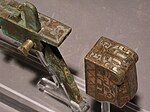
Back قائمة الاختراعات والاكتشافات الصينية Arabic Inventos de la Antigua China Spanish Liste des inventions chinoises French Daftar reka cipta Tiongkok ID Lijst van Chinese uitvindingen Dutch Список изобретений, сделанных в Китае Russian 中國發明 Chinese
| Part of a series on the |
| History of science and technology in China |
|---|
 |
China has been the source of many innovations, scientific discoveries and inventions.[1] This includes the Four Great Inventions: papermaking, the compass, gunpowder, and early printing (both woodblock and movable type). The list below contains these and other inventions in ancient and modern China attested by archaeological or historical evidence, including prehistoric inventions of Neolithic and early Bronze Age China.
The historical region now known as China experienced a history involving mechanics, hydraulics and mathematics applied to horology, metallurgy, astronomy, agriculture, engineering, music theory, craftsmanship, naval architecture and warfare. Use of the plow during the Neolithic period Longshan culture (c. 3000–c. 2000 BC) allowed for high agricultural production yields and rise of Chinese civilization during the Shang dynasty (c. 1600–c. 1050 BC).[2] Later inventions such as the multiple-tube seed drill and the heavy moldboard iron plow enabled China to sustain a much larger population through improvements in agricultural output.
By the Warring States period (403–221 BC), inhabitants of China had advanced metallurgic technology, including the blast furnace and cupola furnace, and the finery forge and puddling process were known by the Han dynasty (202 BC–AD 220). A sophisticated economic system in imperial China gave birth to inventions such as paper money during the Song dynasty (960–1279). The invention of gunpowder in the mid 9th century during the Tang dynasty led to an array of inventions such as the fire lance, land mine, naval mine, hand cannon, exploding cannonballs, multistage rocket and rocket bombs with aerodynamic wings and explosive payloads. Differential gears were utilized in the south-pointing chariot for terrestrial navigation by the 3rd century during the Three Kingdoms. With the navigational aid of the 11th century compass and ability to steer at sea with the 1st century sternpost rudder, premodern Chinese sailors sailed as far as East Africa.[3][4][5] In water-powered clockworks, the premodern Chinese had used the escapement mechanism since the 8th century and the endless power-transmitting chain drive in the 11th century. They also made large mechanical puppet theaters driven by waterwheels and carriage wheels and wine-serving automatons driven by paddle wheel boats.
For the purposes of this list, inventions are regarded as technological firsts developed in China, and as such does not include foreign technologies which the Chinese acquired through contact, such as the windmill from the Middle East or the telescope from early modern Europe. It also does not include technologies developed elsewhere and later invented separately by the Chinese, such as the odometer, water wheel, and chain pump. Scientific, mathematical or natural discoveries made by the Chinese, changes in minor concepts of design or style and artistic innovations do not appear on the list.
- ^ Joseph Needham, Science and Civilisation in China, 1954–2008, Cambridge University Press
- ^ Bray (1978), 27–28.
- ^ Bowman (2000), 104–105.
- ^ Levathes (1994), 37–38.
- ^ Hsu (1988), 96.

